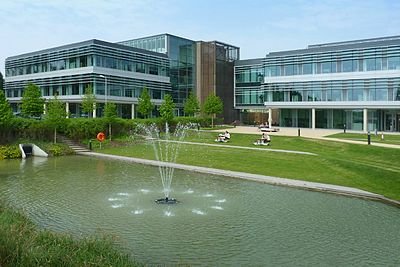British Heritage
Remember, Cherish, Learn.
beta
Science Parks - Cambridge and Oxford
The Legacy of Science Parks in Britain: A Testament to Innovation
The modern landscape of the United Kingdom is punctuated by hubs of innovation: Science and Technology Parks (STPs), or more commonly, science parks. These incubators of invention, primarily associated with leading universities, have had a profound impact on Britain's heritage. They are tangible reflections of the nation's pursuit of knowledge and technological progress, influencing both the domestic economy and international landscape. Particularly, the science parks affiliated with the illustrious Cambridge and Oxford Universities have not only shaped the regions around them but have also contributed significantly to the national and global technological advancements.
Fundamentally, a science park is a property-based venture that nurtures the growth of tenant firms, often early-stage enterprises, and affiliates with a university or research bodies. They provide an environment where innovation is encouraged, knowledge is shared, and research outcomes evolve into commercial products. This symbiosis of academia and industry is designed to bolster national economic development by sparking the creation of high-technology firms, enticing foreign investment, and fostering exports.
The true essence of a science park lies in its ecosystem that facilitates the fusion of minds and exchange of ideas across varied fields. This concept of "cross-fertilisation," as articulated by Pierre Laffitte, the founder of the Sophia Antipolis Science Park in France, underscores the transformative potential of such establishments.
In the context of the UK, Cambridge and Oxford Universities have spearheaded the creation of innovative developments, capitalising on their prestigious academic reputation and access to funding and human capital. These science parks have become incubators for cutting-edge research, entrepreneurial spirit, and economic growth, solidifying their status as vital elements of British heritage.
Cambridge Science Park, founded by Trinity College in 1970, is a prime example of these innovative landscapes. It is home to a range of tech businesses, from promising start-ups to established multinational corporations, all of which contribute to the vibrant Cambridge tech cluster known as the "Silicon Fen."
Oxford Science Park, established in 1991, serves as another testament to the symbiosis of academia and industry. It has cultivated an environment that has fostered the growth of over 90 companies, specialising in fields such as Life Sciences, IT, and Engineering.
The impact of these science parks extends beyond the walls of the institutions. They have transformed their surrounding areas into dynamic economic regions, generating jobs, and stimulating local economies. Through their influence, science parks have also contributed to enriching the quality of life of their workers and the local community.
Moreover, these parks have helped retain and attract skilled talent in the UK, contributing to the development of a competitive workforce. They have also made significant strides in research, leading to the commercialisation of products that have had far-reaching impacts on various sectors including healthcare, technology, and environmental science.
In terms of economic impact, the Science and Technology Park activity across the European Union has seen exponential growth over the past decade. It is estimated that the existing STPs in the EU member states host around 40,000 organisations employing approximately 750,000 people in high value-added jobs. The capital investment into EU STPs from 2000-2012 was around €11.7 billion, underlining their significant role in economic development.
As the world becomes increasingly digital, these hubs of innovation will continue to play a critical role in the British economy. Science parks not only represent the entrepreneurial spirit of the nation but also its commitment to technological advancement and knowledge dissemination. With an increasing understanding of their potential, public sector support for science parks continues to grow.
The Association of University Research Parks (AURP) and the International Association of Science Parks and Areas of Innovation (IASP) provide international recognition and support for these science parks. The Cabral-Dahab Science Park Management Paradigm further refines the defining characteristics and goals of an effective science park, underscoring the need for expertise, long-term economic planning, and a symbiotic relationship with powerful economic actors.
The legacy of British science parks like those in Cambridge and Oxford is far-reaching. They not only contribute to the British heritage but also represent the nation's dedication to pushing the boundaries of knowledge and innovation. As these parks continue to grow and evolve, they are likely to remain at the forefront of technological advancement and economic growth, embodying Britain's relentless pursuit of a future shaped by knowledge and innovation.
A Glimpse into the Essence of Science Parks
Fundamentally, a science park is a property-based venture that nurtures the growth of tenant firms, often early-stage enterprises, and affiliates with a university or research bodies. They provide an environment where innovation is encouraged, knowledge is shared, and research outcomes evolve into commercial products. This symbiosis of academia and industry is designed to bolster national economic development by sparking the creation of high-technology firms, enticing foreign investment, and fostering exports.
The true essence of a science park lies in its ecosystem that facilitates the fusion of minds and exchange of ideas across varied fields. This concept of "cross-fertilisation," as articulated by Pierre Laffitte, the founder of the Sophia Antipolis Science Park in France, underscores the transformative potential of such establishments.
The British Legacy: Cambridge and Oxford
In the context of the UK, Cambridge and Oxford Universities have spearheaded the creation of innovative developments, capitalising on their prestigious academic reputation and access to funding and human capital. These science parks have become incubators for cutting-edge research, entrepreneurial spirit, and economic growth, solidifying their status as vital elements of British heritage.
Cambridge Science Park, founded by Trinity College in 1970, is a prime example of these innovative landscapes. It is home to a range of tech businesses, from promising start-ups to established multinational corporations, all of which contribute to the vibrant Cambridge tech cluster known as the "Silicon Fen."
Oxford Science Park, established in 1991, serves as another testament to the symbiosis of academia and industry. It has cultivated an environment that has fostered the growth of over 90 companies, specialising in fields such as Life Sciences, IT, and Engineering.
The Impact of Science Parks on British Heritage
The impact of these science parks extends beyond the walls of the institutions. They have transformed their surrounding areas into dynamic economic regions, generating jobs, and stimulating local economies. Through their influence, science parks have also contributed to enriching the quality of life of their workers and the local community.
Moreover, these parks have helped retain and attract skilled talent in the UK, contributing to the development of a competitive workforce. They have also made significant strides in research, leading to the commercialisation of products that have had far-reaching impacts on various sectors including healthcare, technology, and environmental science.
In terms of economic impact, the Science and Technology Park activity across the European Union has seen exponential growth over the past decade. It is estimated that the existing STPs in the EU member states host around 40,000 organisations employing approximately 750,000 people in high value-added jobs. The capital investment into EU STPs from 2000-2012 was around €11.7 billion, underlining their significant role in economic development.
Defining the Future: The Evolution of Science Parks
As the world becomes increasingly digital, these hubs of innovation will continue to play a critical role in the British economy. Science parks not only represent the entrepreneurial spirit of the nation but also its commitment to technological advancement and knowledge dissemination. With an increasing understanding of their potential, public sector support for science parks continues to grow.
The Association of University Research Parks (AURP) and the International Association of Science Parks and Areas of Innovation (IASP) provide international recognition and support for these science parks. The Cabral-Dahab Science Park Management Paradigm further refines the defining characteristics and goals of an effective science park, underscoring the need for expertise, long-term economic planning, and a symbiotic relationship with powerful economic actors.
Conclusion
The legacy of British science parks like those in Cambridge and Oxford is far-reaching. They not only contribute to the British heritage but also represent the nation's dedication to pushing the boundaries of knowledge and innovation. As these parks continue to grow and evolve, they are likely to remain at the forefront of technological advancement and economic growth, embodying Britain's relentless pursuit of a future shaped by knowledge and innovation.
- Science parken.wikipedia.org









